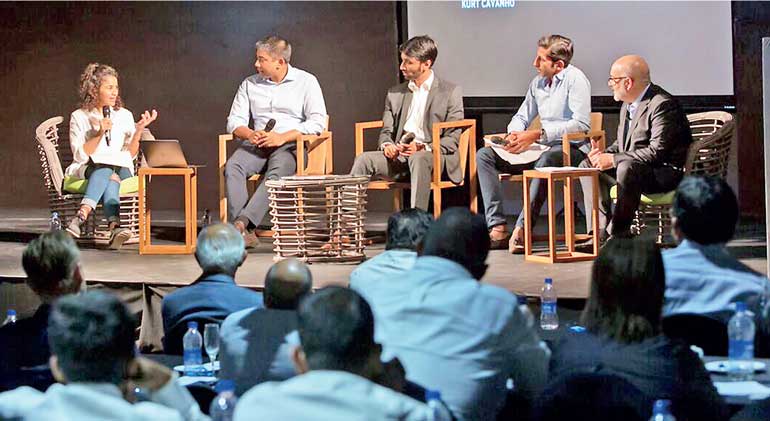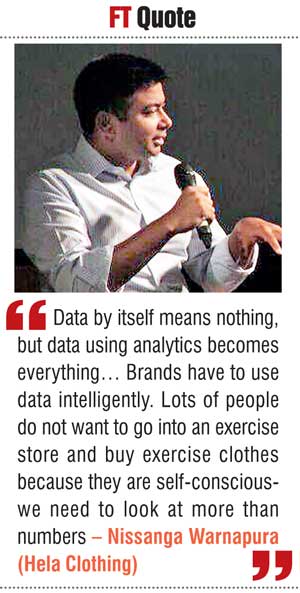Monday Apr 21, 2025
Monday Apr 21, 2025
Wednesday, 30 November 2016 00:01 - - {{hitsCtrl.values.hits}}
 The South Asian Apparel Leadership Forum (SAALF) has been held as part of Sri Lanka Design Festival for the last eight years and has managed to gather great interest from fashion industry professionals in South Asia and abroad.
The South Asian Apparel Leadership Forum (SAALF) has been held as part of Sri Lanka Design Festival for the last eight years and has managed to gather great interest from fashion industry professionals in South Asia and abroad.
This year, the forum brought into highlight the wave of change taking place across all industries including fashion, and how to use  this transformation as an opportunity, opposed to seeing it as a challenge. With a series of power-packed sessions from some of the world’s leading game-changers in fashion and apparel, this forum delivered fresh insights and new knowledge to harness the power of change.
this transformation as an opportunity, opposed to seeing it as a challenge. With a series of power-packed sessions from some of the world’s leading game-changers in fashion and apparel, this forum delivered fresh insights and new knowledge to harness the power of change.
Among the key discussions held was the panel moderated by the forum chair Kurt Cavano – the Founder and President of GT Nexus, an Infor company, between the young generation of apparel manufacturing leaders – Aroon Hirdaramani, Jehan Jayasooriya, Nissanga Warnapura and Amreen Ashraf. Their discussion was built around how, with the emergence of global platforms and other new business models, finally, means that talent, culture, and organisational forms will have to be rethought.
Collaboration is key in manufacturing for the fashion-intelligent consumer
The young decision makers of the industry were specifically invited to share their insights at SAALF this year for a special reason. With ‘transformation’ being the key theme of the overall festival and the forum being held under the theme ‘disrupt, reinvent, transform!’ it was clear that the direction of the discussion was an informed and intellectual reshaping of the future: It is in this light that the fresh energy and perspectives of the future leaders of the industry were highlighted at the forum.
Their discussion on ‘Rethinking Talent, Culture and Business Models’ called for more collaborative and multi-disciplinary approaches for the apparel industry in the new age with more interaction with their global counterparts in various other manufacturing and retailing nations.
Aroon shed light on why collaboration and welcoming new knowledge are important in understanding today’s consumer who changes every minute; “We are ethical, we are sustainable. But Millennials are thinking different. They want something they see on SnapChat, they want it customised, they want it sustainable and they want it yesterday. Sri Lanka has based buying decisions based on last year’s decisions, but now buying patterns have changed as consumers get more fashion-intelligent.”
Competing the ‘cheap needle’ with design value addition
It’s not easy to win against cheap fashion. When Sri Lanka made the strategic decision to take the high road by not complying with the cheap needle, it became important to find what will then become the big selling point for Lankan apparel.
MAS Intimates’ Jehan Jayasooriya talked about shifting our value proposition into design, and the importance of developing a competency in speed to react to consumer needs faster and also going the last mile from the point of production to point of consumption: “I think one of the fundamental shifts that we may need to look at is to re-look and re-design the scope of Sri Lankan apparel in terms of value addition to fashion. As an industry we have little or no real connection to the consumer. We need to disrupt our business models, understand the consumers’ social and behavioural needs, see trends and also use data analytics to predict and use this for design and consumer chains.”
Nissanga Warnapura of Hela Clothing added to this by stressing on the importance of data analytics which, according to him, is the true power to interpret and analyse the future. “Data by itself means nothing, but data using analytics becomes everything,” he stated and explained how it is the one thing that helps us understand and observe how consumers behave so that we can then move in unison with them.
Retail is broken; what’s in for the future?
Amreen Ashraf of Timex tackled the topic of the future of retail and mentioned that it is not about trying to get retail back into what it was in the ’90s but rather understand its new form of the future. “It’s not about fixing retail, it’s about evolving and changing. Capitalistic consumerism and pushing brands to make sales year end on year end is no longer relevant. Bio mimicry is a huge trend with more urbanism taking life. Climate change is causing havoc and smaller multi-disciplinary teams working together with radical agility is everything.”
Ashraf further stated that the new now, the freshly informed, intelligence and responsiveness are what consumers today want; “I saw a coat online that changes its temperature with the environment around you. That is what my generation is looking for.”
Cultivating change
Creating a culture that is open to change and embraces it fully is a challenge. How can Sri Lankan apparel makers transform  decades’ old business models to new-age ones that embrace transformation?
decades’ old business models to new-age ones that embrace transformation?
Aroon Hirdaramani set down an important point: “I don’t think we have all the answers. We do need the change in thinking. We need to encourage co-working spaces. Apparel one of the largest industries in the world. We need thought leaders from all over the world who will work and share their talents with us.”
Hirdaramani’s call to welcome new knowledge and collaborative growth with global counterparts was strengthened by MAS Intimates’ Jehan Jayasooriya’s statement on open innovation. “One of the things companies can do to foster change is to encourage open innovation. Change comes slow when you try to bring about change organically. Your innovation will speed up if you bring it from outside.”
He also went on to say that larger organisation need to form smaller teams that can innovate and change the climate of the industry in order to maintain a culture of change without relaxing upon previous successes. Amreen Ashraf of Timex also added on the importance of creating a culture where you can be open, allow for failure to rethink, rework and even use failure as a reiterative process.
Going straight to the consumer
Exploring B2C avenues is not a new idea to Sri Lanka apparel. But the recent times have presented new and improved ways of doing this instead of confining to traditional retail. Commenting on the future of brands, a path that the Lankan apparel industry has already invested on, Aroon Hirdaramani discussed why it is essential to pursue brands with a new way of thinking: “Brand loyalty is not very important to consumers any more- consumers also understand this...”
Nissanga Warnapura of Hela Clothing directed the discussion towards the importance of data and mining the correct information from both meta and traditionally collected data, in fashion’s aged-old battle with getting the right fit –
a challenge that needs attention as consumers demand for customisation in everything. “Brands have to use data intelligently. Lots of people do not want to go into an exercise store and buy exercise clothes because they are self-
conscious – we need to look at more than numbers,” he stated, hinting on how information can enlighten us on what consumers really want.
Insight from first gen apparel leaders
Adding the experienced vision of senior apparel leaders into this conversation, Chairman of MAS Holdings, Deshamanya Mahesh Amalean commented at the conclusion of the panel. Amalean’s comment summed up the discussion and brought in the much needed closure for the panel where the manufacturing-only mind-sets and the traditional operating models were highlighted as what needed to be changed in order to take on the new future of apparel.
The industry icon stated the following: “I think there are two things here that are holding us back- one is the mind-set where we see ourselves only as manufacturers and not merchants as well as retailers. Probably the second thing is not having the competency and the capability to reach beyond manufacturing because our systems and business models are wired only to be that. I think the first one – the mindset shift is the most challenging. Becoming a retailer and going straight to the consumer takes a lot of change in the way we think and understand the consumer need. We’re currently so highly programmed to be tuned into what our customer wants, but not the end consumer needs. And this is what is holding us back.”
Responding to the forum chair GT Nexus President Kurt Cavano on whether the Lankan apparel industry can really make that change, Amalean stated the following: “I think some are attempting to do consumer service and engage with them directly, outside the feedback given by the middle customer. Some digital retailers like Zalando and Amazon are looking at different business models where they don’t limit themselves and we too need to do that change.”
With Sri Lankan fashion manufacturers looking to make winds of change into an opportunity rather than a challenge, the South Asian Apparel Leadership Forum’s 2016 edition played a pivotal role in gathering a new body of knowledge for the industry. The fresh insights from the future leaders of apparel proved to be an all-important contribution to this new knowledge body that aims propel the industry into a brand new future.
For partnerships, participation and more information, contact the SLDF secretariat on 076 777 0306 or email [email protected].